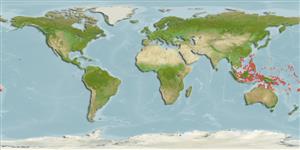Environment: milieu / climate zone / depth range / distribution range
Écologie
marin; eau douce; saumâtre démersal; amphidrome (Ref. 51243). Tropical; 29°N - 20°S
Asia and Oceania: Ryukyu Islands in Japan, Taiwan, Philippines, Indonesia, Solomon Islands, New Guinea and northern Australia. Reported from Palau (Ref. 6371), Fiji (Ref. 12743) New Caledonia (Ref. 13235) and Vanuatu (Ref. 97791).
Taille / Poids / Âge
Maturity: Lm ? range ? - ? cm
Max length : 14.0 cm SL mâle / non sexé; (Ref. 7050)
Épines dorsales (Total): 7; Rayons mous dorsaux (Total): 9; Épines anales 1; Rayons mous anaux: 8. Distinguished by the following characters: mouth moderate; reaching to a point below anterior margin to middle of eye; operculum with a small patch of 10-20 scales dorsally in 2-3 longitudinal rows; second dorsal rays I,8; pectoral rays 18-21 (usually 19 or 20); predorsal scale count 15-19; one or usually two small lateral canal head pores above anterior operculum just before terminal lateral canal pore; papilla line 6 well developed; papilla lines composed of a single row of papillae; snout length 11.6-13.6% SL ; body with 5 oval, horizontally elongate brown to black spots on midside from second dorsal origin to posterior end of caudal peduncle; spots usually bordered by faint brown lines above and below.
Adults live in clear streams, usually close to the sea (Ref. 5259). They occur mainly in fresh water, but larvae in marine environment (Ref. 5259).
Life cycle and mating behavior
Maturité | Reproduction | Frai | Œufs | Fécondité | Larves
Allen, G.R., 1991. Field guide to the freshwater fishes of New Guinea. Publication, no. 9. 268 p. Christensen Research Institute, Madang, Papua New Guinea. (Ref. 2847)
Statut dans la liste rouge de l'IUCN (Ref. 130435)
Menace pour l'homme
Harmless
Utilisations par l'homme
Pêcheries: intérêt commercial mineur
Plus d'informations
Noms communsSynonymesMétabolismePrédateursÉcotoxicologieReproductionMaturitéFraiRassemblement de ponteFéconditéŒufsDéveloppement de l'œuf
RéférencesAquacultureProfil d'aquacultureSouchesGénétiqueElectrophoresesHéritabilitéPathologiesTraitementNutrientsMass conversion
CollaborateursImagesStamps, Coins Misc.SonsCiguateraVitesseType de nageSurface branchialeOtolithesCerveauxVision
Outils
Articles particuliers
Télécharger en XML
Sources Internet
Estimates based on models
Preferred temperature (Ref.
123201): 27.1 - 29.3, mean 28.7 °C (based on 1441 cells).
Phylogenetic diversity index (Ref.
82804): PD
50 = 0.5000 [Uniqueness, from 0.5 = low to 2.0 = high].
Bayesian length-weight: a=0.01023 (0.00477 - 0.02194), b=3.02 (2.84 - 3.20), in cm total length, based on LWR estimates for this (Sub)family-body shape (Ref.
93245).
Niveau trophique (Ref.
69278): 3.3 ±0.42 se; based on food items.
Résilience (Ref.
120179): Haut, temps minimum de doublement de population inférieur à 15 mois (Preliminary K or Fecundity.).
Fishing Vulnerability (Ref.
59153): Low vulnerability (10 of 100).
